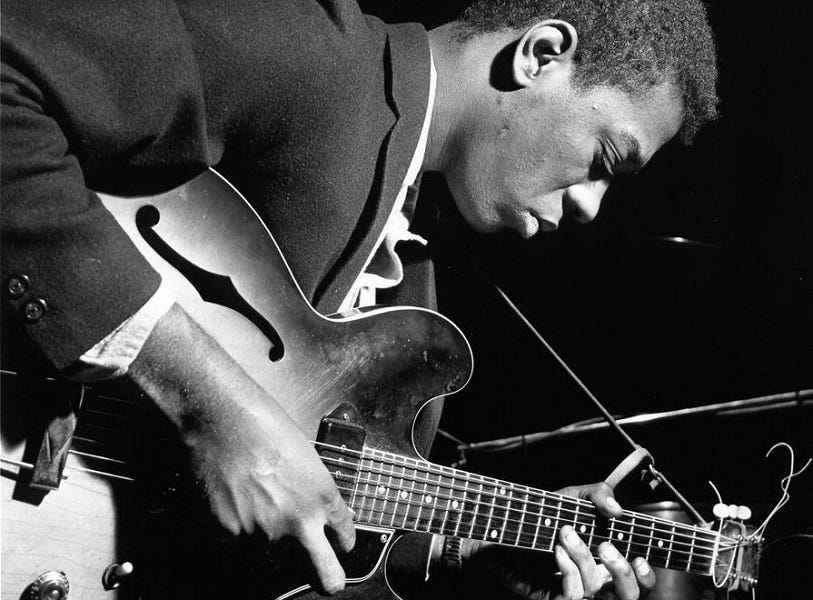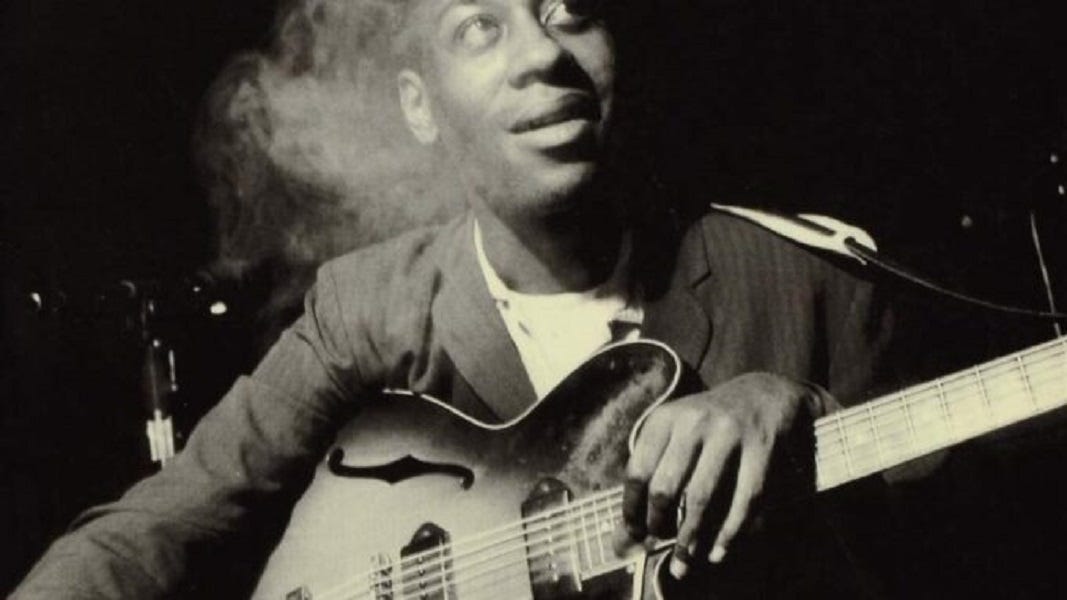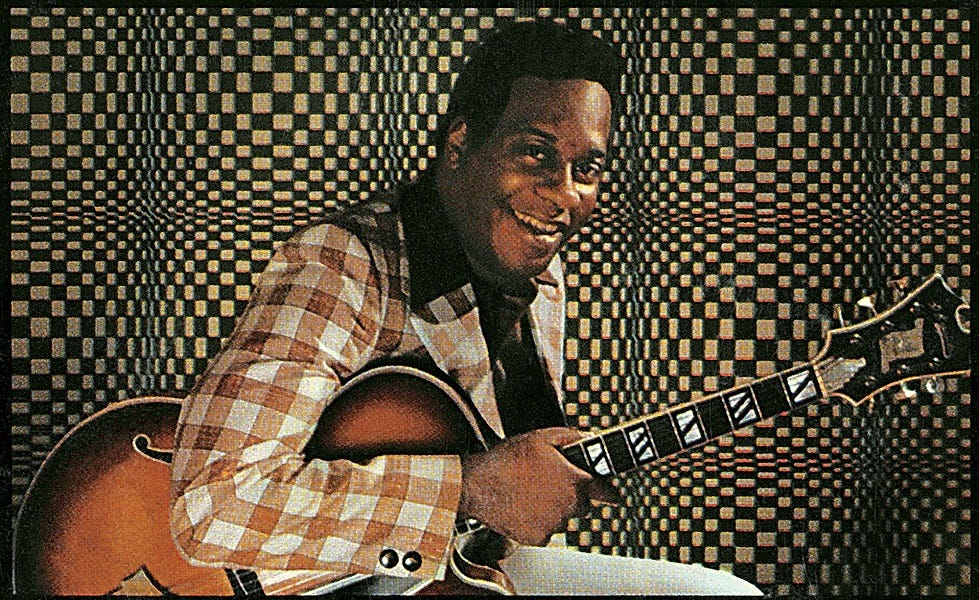Grant Green (June 6, 1935 – January 31, 1979) – Bedouin (1964)
The great jazz guitarist recorded this beautiful jazz cut with Coltrane quartet legends McCoy Tyner and Elvin Jones, unreleased until after his tragic death in 1979.
View most updated version of this post on Substack
Search our full archives
Forty-five years ago on January 31, 1979, the great jazz guitarist Grant Green died from a heart attack in New York City. He was a mainstay on Blue Note Records releases during the first half of the 1960s, playing on more records as a leader or sideman than any other artist. Fellow legends Wes Montgomery and George Benson both considered him their all-time favorite guitarist.
Born in St. Louis, Missouri, Green picked up the guitar while in elementary school. His father played guitar, and taught him blues and folk songs. He took guitar lessons for a year but mostly learned to play by listening to records. When he was 13 he began playing in a gospel ensemble. He was a member of both jazz and R&B bands in St. Louis during the 1950s.
In 1959, he was discovered playing at a St. Louis bar by saxophonist Lou Donaldson, who invited him to join his touring band. Green moved to New York City within the next year, where Donaldson introduced him to Blue Note Records co-founder and producer Alfred Lion. From 1961-65 he served as the label’s in-house guitarist, and played on over 70 records during those years alone released on Blue Note and other labels including Prestige, Verve, Impulse! and Atlantic.
Here’s a playlist with 14 of his albums as leader on Blue Note during the sixties. Two which remained unreleased until shortly after his death were recorded in the spring of 1964 at Van Gelder Studio in Englewood Cliffs, NJ. Both featured Sonny Rollins’ longtime bassist Bob Cranshaw and Coltrane quartet legends McCoy Tyner on piano and Elvin Jones on drums.
The first was Matador, recorded on May 20, 1964 but not released until 1979 on the Japanese Blue Note label. It featured a stellar version of “My Favorite Things” on which Green’s guitar substituted for Coltrane’s tenor sax. The album’s masterpiece was arguably the phenomenal “Bedouin,” written by pianist Duke Pearson, who served as Blue Note’s A&R head and went on to produce several of Tyner’s solo albums.
Green, Tyner, Jones, and Cranshaw returned to Van Gelder Studio on June 12 for another session, joined this time by James Spaulding on alto sax and Joe Henderson playing tenor. The result was Solid, a record today regarded as one of Green’s best straight-ahead jazz records, which Blue Note finally released in 1979. It opened with another great Pearson composition, “Minor League,” and contained a swinging track Green wrote called “Grant’s Tune.”
Starting in the mid-sixties, Green began mixing soul and funk into his sound. In 1965 he released the album His Majesty King Funk, produced by Creed Taylor for Verve, with organist Larry Young and the Afro-Cuban jazz pioneer Cándido on percussion. Green wrote its title track, a funky soul-jazz workout titled “The Selma March.”
Sadly, he also became addicted to heroin during this period, and from 1966-69 appeared on only a handful of records. In October, 1969 he returned to Blue Note and recorded Carryin’ On, which was released in the spring of 1970. It planted him firmly in jazz-funk territory with funky tracks like “Upshot,” which he wrote. The LP closed with a laid back, beautiful plea for peace in response to Nixon’s escalation of the Vietnam War. “Cease The Bombing” was written by organist Neal Creque, who played electric piano on it.
Green’s next few albums for the label embraced jazz-funk, and most were produced by George Butler. The former United Artists A&R head took over running Blue Note in 1972 and helped push the entire label in a funky direction.
Shades of Green was recorded in November, 1971 in Los Angeles with Crusaders Wilton Felder on electric bass and Nesbert “Stix” Hooper on drums alongside Green. It included James Brown and Stevie Wonder covers, and closed with the funk bomb “In The Middle,” a cover of a track co-written by Brown’s bandleader Alfred “Pee Wee” Ellis who had released it under his own name in 1969.
Also in late 1971, Green was hired to score the soundtrack to the Black revolutionary drama The Final Comedown (1972), written and directed by cult Blaxploitation auteur Oscar Williams in his big screen debut. The film’s producers included Williams and Roger Corman, whose New World Pictures distributed it.
The Final Comedown was notable as the first soundtrack ever released on Blue Note. Produced by Butler, its highlights were the beautiful “Fountain Scene,” the funky jam “Afro Party,” the haunting “Father’s Lament,” and the soundtrack’s epic closing cut “Battle Scene.”
Years of heroin addiction took their toll on Green’s body, and his health worsened throughout the seventies. He spent much of 1978 in the hospital, but with mounting bills and children to support, checked himself out against doctor’s orders and went back on the road. In late January, 1979, he drove cross-country from New York to California for a gig in Hermosa Beach, then drove back. After returning to New York, he suffered a massive heart attack and died, gone far too soon at age 43.
In 2016, the independent documentary The Grant Green Story premiered at the Harlem International Film Festival. It featured many rare interviews with Green’s contemporaries and collaborators including Lou Donaldson, George Benson, and Rudy Van Gelder. Co-produced and co-directed by Sharony Green, the former wife of Green’s son Grant Jr., the film was an emotional look at a son’s search for his late father.
Rest in Power, Grant Green.
Further info:
The Grant Green Story, documentary, Parts 1, 2, and 3, 2016.
“Get Ready for Some New, Revelatory Recordings of the Jazz Guitarist Grant Green,” by Richard Brody, The New Yorker, May 22, 2018.
“Celebrating the Artistry of Grant Green,” Jazz Guitar Today, October 8, 2021.
#jazz #BlueNote #GeorgeButler #McCoyTyner #GrantGreen






